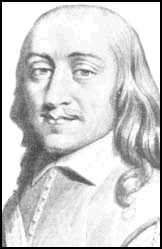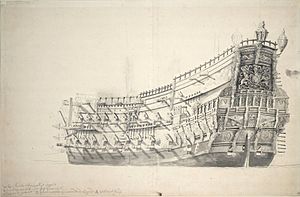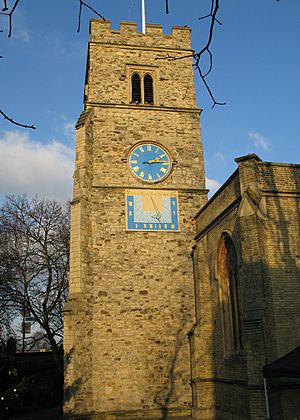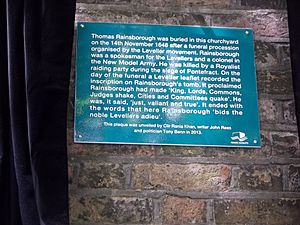Thomas Rainsborough facts for kids
Quick facts for kids
Thomas Rainsborough
|
|
|---|---|

Thomas Rainsborough
|
|
| Commander of Parliamentarian navy Captain of Deal Castle |
|
| In office September 1647 – May 1648 |
|
| Member of Parliament for Droitwich |
|
| In office January 1647 – October 1648 |
|
| Parliamentarian Governor of Worcester | |
| In office July 1646 – April 1647 |
|
| Personal details | |
| Born | 6 July 1610 Wapping, London, England |
| Died | 29 October 1648 (aged 38) Doncaster, England |
| Cause of death | Assassinated |
| Resting place | Cemetery attached to St John's Church, Wapping |
| Spouse | Margaret Rainsborough |
| Relations | William Rainsborowe, brother and Ranter |
| Children | William, unnamed daughter |
| Parent | William Rainsborough; |
| Occupation | Soldier, naval officer and radical politician |
| Military service | |
| Allegiance | Parliamentarian |
| Years of service | 1642–1648 |
| Rank | Vice-Admiral; Colonel |
| Battles/wars | |
Thomas Rainsborough (born July 6, 1610, died October 29, 1648) was an English soldier and politician. He was a very important person during the Wars of the Three Kingdoms. These wars included the English Civil War.
Thomas Rainsborough was known for his strong beliefs in fairness. He thought everyone, rich or poor, should have a say in how the country was run. He famously said, "the poorest hee ... in England hath a life to live, as the greatest hee." This idea was very new and brave for his time.
Contents
Who Was Thomas Rainsborough?
Thomas Rainsborough was a brave soldier and a leader in the Parliamentary army, called the New Model Army. He also served in the navy. People thought he was as popular and inspiring as Oliver Cromwell. He was known for being a very skilled and courageous fighter.
Early Life and Family

Thomas Rainsborough was born in Wapping, London, on July 6, 1610. His father, William Rainsborough, was a rich merchant. William was offered a special title, a baronetcy, for helping with a peace treaty. But he said no.
Thomas had two younger siblings, William and Martha. He also had three half-siblings from his father's second marriage.
Like many people who believed in the Puritan religion, Thomas thought about moving to America. His brother William and two sisters did move to Massachusetts. One sister, Martha, married John Winthrop, who was the Governor of the colony.
Thomas married a woman named Margaret. They had a son, William, and at least one other child.
Fighting in the Civil War
Thomas Rainsborough joined the navy, just like his father. Many sailors and merchants who were Puritans worked together. When the First English Civil War started in 1642, Thomas became a captain in the navy. Most of the navy supported Parliament.
The king, Charles I, did not have a strong navy. So, the Parliament's fleet mostly helped with battles on land. They also stopped supplies from reaching the Royalist side. Thomas spent his first year in the war patrolling the Irish Sea. His brother William, who had returned from America, was with him.
Army Commander
In 1643, Thomas left the navy to join the army. He helped defend Hull from an attack. He was promoted to colonel. In 1644, he led a new group of soldiers. Some volunteers from New England, including his brother-in-law, joined his group. He led a brave attack that captured Crowland Abbey.
In 1645, Thomas became a colonel in the new New Model Army. Some people in Parliament did not like his appointment. They worried about his strong religious views. He was known to be sympathetic to groups like the Fifth Monarchists and Anabaptists. These groups were not popular with mainstream Protestants.
Thomas fought bravely at the Battle of Naseby in June 1645. His soldiers helped stop a charge by the king's cavalry. He also helped recapture Leicester. Then he fought in the Western Campaign. He showed great skill at sieges, which are battles to capture a fortified place. He helped capture Bridgwater and Bristol.
After taking Berkeley Castle in December 1645, he helped with the Siege of Oxford. Oxford surrendered in June 1646. This ended most of the fighting in the First English Civil War. Thomas then helped finish the Siege of Worcester. He became the governor of Worcester in July 1646. He was also elected as a Member of Parliament for Droitwich.
The Putney Debates
By 1647, the New Model Army had not been paid for a long time. Parliament was having money problems. The king refused to agree to a peace deal. Some members of Parliament, called moderates, wanted the king to rule with Parliament. They saw radical people like Rainsborough as a bigger problem than the Royalists.
The moderates tried to send the New Model Army to Ireland. They said only soldiers who agreed to go would be paid. The army leaders refused. They demanded full payment for everyone. The army was officially disbanded, but its leaders would not obey.
Thomas Rainsborough was very influential. He joined the General Council, a group formed to protect the army's interests. This council included senior officers like Cromwell and soldiers elected by their regiments. Thomas believed that talking with the king was useless. He even accused Cromwell of being too eager to please the king.
In August 1647, Rainsborough's regiment stopped riots in London. During this time, he helped create ideas for a new government. These ideas were written in a paper called An Agreement of the People. It asked for freedom of religion for non-Catholics. It also demanded that everyone be equal before the law. Most importantly, it asked for all men over 21 to have the right to vote. This was a very radical idea for the time.
The Putney Debates happened from October 28 to November 8, 1647. They took place at St. Mary's Church, Putney. The goal was to agree on what the army wanted from Parliament. Thomas Rainsborough was a main speaker for the idea of equality. He argued that every man should have a say in the government. He said:
" ...for really I thinke that the poorest hee that is in England hath a life to live as the greatest hee; and therefore truly, Sir, I thinke itt's cleare, that every man that is to live under a Governement ought first by his owne consent to putt himself under that Governement; and I do think that the poorest man in England is not at all bound in a strict sense to that Government that he hath not had a voice to put Himself under."
The army leaders ended the debates. They thought these ideas would hurt army discipline. Soldiers had to sign an oath of loyalty to their officers. Thomas Rainsborough was present at one meeting where a small mutiny happened. He had already left his army role to become a vice-admiral in the navy. But Parliament then took away his navy job.
Later Battles and His Death

The political situation got worse. There were rumors that Royalists would rise up again. The army leaders needed a reliable person to lead the navy. They asked Parliament to make Rainsborough commander again. He became commander in January 1648. He also became Captain of Deal Castle. His main ship was the Constant Reformation.
However, many sailors did not like having an army officer in charge. They did not support his political or religious views.
The Second English Civil War began in February 1648. It was a fight between Scottish forces, English Royalists, and some Parliamentarians. On May 27, six ships, including Rainsborough's Constant Reformation, declared support for the king. The crew put Rainsborough into a small boat. Parliament then put a different leader in charge of the navy.
Rainsborough returned to the army. He joined Sir Thomas Fairfax at the Siege of Colchester. This siege ended in August.
Rainsborough then moved to the siege of Pontefract Castle. This was one of the last places still held by the Royalists. On October 29, four men broke into his house in Doncaster. They wanted to capture him. Rainsborough fought back and was killed in the street.
After his death, some people thought army leaders might have been involved. But an investigation found no proof for this idea.
Thomas Rainsborough was buried next to his father in St John's Church, Wapping. His funeral was attended by about 3,000 people who supported his ideas. Parliament gave his wife, Margaret, money and land.
In May 2013, a special plaque was put up in Wapping to remember Thomas Rainsborough.
Images for kids




